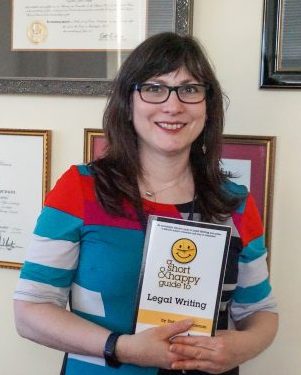Professor Deborah L. Borman, a faculty member at the UA Little Rock William H. Bowen School of Law, has written A Short and Happy Guide to Legal Writing. It is part of West Academic’s Short and Happy series which began in 2011 with A Short and Happy Guide to Property by Professor Paula Franzese.
 “The title is a misnomer,” Professor Borman says. “There is no short way to teach legal writing. There are no short-cuts, no acronyms for substantive rules, no data to memorize.”
“The title is a misnomer,” Professor Borman says. “There is no short way to teach legal writing. There are no short-cuts, no acronyms for substantive rules, no data to memorize.”
“Because of that, learning legal writing doesn’t make students or practitioners happy,” she continues. In Chapter 4, she compares legal citations to swimming with sharks.
“It’s not even really about writing so much as it is about retraining yourself in analysis and oral advocacy. That isn’t an easy process for anyone.”
Borman spent four years writing this guide. The topics are broken into simple and/or memorable structures that jumpstart readers’ critical thinking process.
Instead of being a list of rules or dos and don’ts on legal style, the guide is organized to tell the story of legal advocacy. “Advocacy is supposed to be compelling,” Borman says. “A list of rules isn’t compelling.”
Beginning with the documents that shaped the American legal system, the guide explains how those documents affect the current framework and context of U.S. law. “I’d like students to understand there’s a connection between what exists, what they’re learning, and what they will be adding to advocacy for future generations,” Borman said. “Legal writing isn’t done in vacuum. Everything they write becomes part of that history.”
After history comes the discussion of legal authority and each source may build on another, which she likens it to an elevator. Next is the citation chapter, “Swimming with Sharks,” which anyone who has had to interpret The Blue Book will understand. Borman helps explain citations by likening them to reading an address or directions.
Building on sources and citations, the guide then dissects objective (legal memos) and persuasive (legal briefs) writing. The algorithms that come into play here are TREACC for objective writing and CRAC for persuasive writing.
Borman also offers a chapter of quick tips, a primer chapter, and a brief chapter on grammar and structure.
“I wanted to create a honed in, useful guide for conducting legal analysis and fostering better advocacy,” Borman said. “Lawyers are responsible to their clients, to the legal community, and to society as a whole. We must be clear communicators and advocates not just for our clients but for the legal system. No matter what you call it, if you don’t understand the theory behind legal analysis, you won’t be able to do it well.”